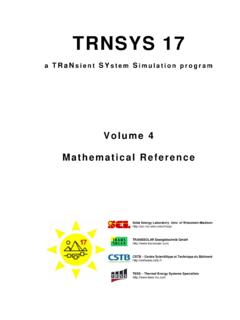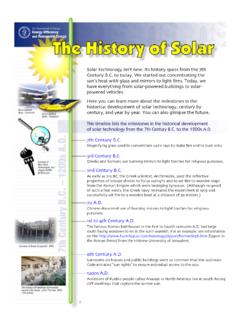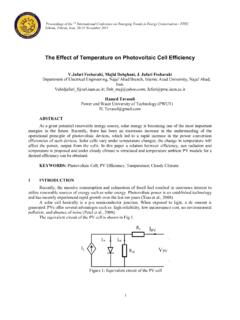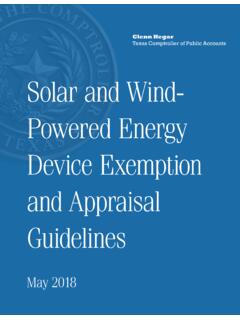Transcription of Solar Radiation Measurements - NREL
1 Solar Radiation Measurements : A Workshop For The National Association of State Universities and Land Grant Colleges By Tom Stoffel & Steve Wilcox Hydrogen & Electric Technologies & Systems Center August 4, 2004. Outline Introductions Shining On, A Primer on Solar Radiation Data What are Solar Radiation Measurements ? Why do we need Solar Radiation data? What influences the amount of Solar Radiation ? How do we use Solar Radiation data? How accurate do the data need to be? How are we meeting our Solar Radiation data needs? Where can you obtain Solar Radiation data? Pop Quiz No acronyms! Introductions Tom Stoffel & Steve Wilcox Resource Integration Group Measurement & Instrumentation Team Geographic Information System Team 40+ years experience: Solar measurement station/network design SRRL, HBCU, Saudi, DOE/ARM, NOAA, WMO/BSRN, GAW.
2 Radiometer calibration and characterization BORCAL/RCC. IPCs, NPCs Solar data quality assessment SERI-QC. DQMS. What are Solar Radiation Measurements ? Energy from the Sun at the Earth's Surface Different parts of the sky Change with time (minutes, hours). Change with time (seasons, years, decades). Change with location What are Solar Radiation Measurements ? Light from the sky dome Direct from the sun Everywhere but the sun Entire sky We call it Direct (beam). Diffuse (sky). Global (total). Global is the sum of direct and diffuse What are Solar Radiation Measurements ? Direct Normal Global Horizontal Diffuse Measured by a Measured by a Measured by a Pyrheliometer on a Pyranometer with a shaded Pyranometer sun-following horizontal sensor under a tracking ball tracker Solar Irradiance Components Global = Direct Normal * Cos(Z) + Diffuse Z.
3 Cos (Z) = 8/18. Z = Cos-1( ). Z = . 18 dots 8 dots Clear Sky Direct (Beam). Global (Total). Diffuse (Sky). Thermopile Detectors How do the radiometers work? Thermo-electric detectors: Two metals + Heat = Electrical Current Copper-Constantan wire wound Thermopiles The Eppley Laboratory, Inc. Thermopile Detectors Pyrheliometer 1st Class $, flat Spectral Response, Slow . Pyranometer The Eppley Laboratory, Inc. Photoelectric Detectors Fast, Low-Cost, with Reduced Spectral Response: Partly Cloudy Sky Direct (Beam). Global (Total). Diffuse (Sky). Changes with Time & Location: Annual Cycle Changes with Time: Inter-annual Monthly Clear Sky Maximum Direct Normal Irradiance SRRL Baseline Measurement System Data: 1986-2002.
4 1100. 1050. 1000. 950. 900. Mt Pinatubo June 1991. 850. Jan- Jan- Jan- Jan- Jan- Jan- Jan- Jan- Jan- Jan- Jan- Jan- Jan- Jan- Jan- Jan- Jan- 86 87 88 89 90 91 92 93 94 95 96 97 98 99 00 01 02. Year Changes with Time: Inter-annual MONTHLY MEAN DAILY TOTALS. Solar Radiation Research Laboratory 1986-2000. 8000. Direct Trend y = - 26829. SEASONALLY ADJUSTED MONTHLY MEAN. 7000 2. R = 6000. [W-hr/sq m]. 5000. 4000. 3000 Global Trend y = - R2 = 2000. 1985 1986 1987 1988 1989 1990 1991 1992 1993 1994 1995 1996 1997 1998 1999 2000 2001. Spectral Distribution of Solar Radiation Broadband Solar Radiation : 280 nm - 3,000 nm QuickTime and a TIFF (Uncompressed) decompressor are needed to see this picture.
5 (99% of shortwave irradiance at the surface). Spectral Irradiance Basic Solar Spectral Regions: Ultraviolet ..200 - 400 nm Visible ..400 - 700 nm Infrared ..700 - 3000 nm Follow the Photons! Photovoltaic Responses ASTM Standard: AM Global @ Tilt Simple Model for Atmospheric Radiative Transfer of Sunshine SMARTS. SMARTS. Available from nrel : Why Do We Need Solar Radiation Data? Agriculture Photosynthesis Astronomy Solar Output Variation Atmospheric Science Numerical Weather Prediction Climate Change Energy Balance Health UV effects on skin Hydrology Evaporation Materials Degradation Oceanography Energy Balance Photobiology Light and Life Renewable Energy Sustainability Why Do We Need Solar Radiation Data?
6 Renewable Energy The amount of Solar energy reaching the earth's land areas in 1 hour is enough to supply the energy needs for 1 year (~100 Quads/yr). Photovoltaics Solar Heat-thermal Solar Heat-electric Solar Fuel-biomass Passive Solar Lighting Building HVAC. Solar Detoxification What Influences the Amount of Solar Radiation ? Solar output 11 year Solar cycle Earth-Sun distance annual variation Clouds Dominant factor Water vapor Selective absorber Air pollution 40% less direct Smoke from forest fires Natural or man-made Volcanic ash Global effect for years Location Time of day Solar position Season Solar Constant . World Radiation Center, Davos, Switzerland What Influences the Amount of Solar Radiation ?
7 Earth's Orbit: Earth-Sun distance Relative tilt Time of day What Influences the Amount of Solar Radiation ? How Do We Use Solar Radiation Data? Technology Selection Siting System Design Performance Monitoring flat plate and Concentrating Collectors Effective Load PV Energy kWh/kW-yr Carrying Capacity 2. Source: Christy Herig ( nrel ) and Richard Perez (SUNY/Albany). z PV can provide peak shaving in many parts of z During off-peak periods, PV capacity can be applied to hydrogen generation An Integrated Analysis Utilizing GIS can Assist With Energy and Environment Planning Efforts Satellite-Derived Techniques Provide Improved Site-Time Coverage (SUNY/Albany). 420. 400. 260. 380.
8 360. 250. 340. 320. 240. 300. 280. 230. 260. 200. 220 240. 180. 210 220. 160. 200 140. 120. 100. 190. GLOBAL IRRADIANCE (average ) DIRECT IRRADIANCE (average ). How Do We Use Solar Radiation Data? General Circulation Model Development MIT. Radiant Fluxes? DOE/Atmospheric Radiation Measurement (ARM) Program How Accurate Do the Data Need to Be? What are the risks? Cost/Benefit of Resource Assessment approach What is the application? Daylighting & building thermal performance Concentrating collector Solar Power Plant Cloud forcing analyses for climate change research What is the period of interest? Measurement uncertainties decrease with longer averaging intervals (averaging can remove random errors).
9 Recent data more accurate than historical records (technology advancements). How Accurate Do the Data Need to Be? What is possible? Measurement Uncertainty Estimates*. Pyrheliometer Pyranometer (Direct Normal) (Global). Calibration Field Data (Best practice) ~ 5% ~ 5%. * Instantaneous data intervals How Will We Meet Our Solar Radiation Data Needs? Research Activities: Solar Radiation Research Laboratory Metrology Optics Electronics Data Acquisition Photovoltaic Program Radiometric Measurements Climate Change Broadband Radiometer Mentor Collaborations WMO, UNEP, NCAR, NOAA, state & local govt, academia Solar Radiation Research Lab Baseline Measurements Radiometer Calibrations Instrument Development Station Operator Training Solar Radiation Research Lab Baseline Measurements (98 data elements).
10 Rotating Shadowband Pyranometer Radiometer Calibrations World Radiometric Reference nrel Transfer Standards NPC. At SRRL. Radiometer Calibrations National Solar Radiation Data Base NSRDB Stations Solar Measurement Stations (1961-1990) (1990 - Present). Automatic Data Quality Assessment Where Can You Obtain Solar Radiation Data? Renewable Resource Data Center Measurement & Instrumentation Data Center nrel Map Server World Radiation Data Center National Climatic Data Center DOE Atmospheric Radiation Measurement Program NOAA Climate Monitoring & Diagnostic Laboratory NOAA Surface Radiation Research Branch Key Points Accurate information is important for policy decisions, technology selection, siting, designing,and monitoring the performance of Solar energy conversion systems Accurate Measurements are important for model development The work we do to improve Solar Measurements Calibration Instrument characterization Measurement techniques (operations and maintenance, radiometer selection.)


















